Global Spatial Suitability Mapping of Wind and Solar Systems Using an Explainable AI-Based Approach
Abstract
:1. Introduction
2. Materials and Methods
2.1. Data Acquisition and Preparation
2.1.1. Sample Inventory
2.1.2. Conditioning Factors
2.1.3. Training Dataset Extraction
2.2. Dataset Pre-Processing
- Handling missing values: All missing values, whether for nominal or numeric attributes, are replaced by means and modes of the training data.
- Removal outliers and extreme values: A filter is applied based on interquartile ranges to detect and remove outliers and extreme values that fall outside of what is expected.
- Data balancing: For ML algorithms to operate unbiased, the number of samples must be balanced for each dependent variable [66]. To do so, our datasets were resampled by applying the Synthetic Minority Oversampling TEchnique (SMOTE), in which the minority samples are duplicated based on the minority data population.
- Normalization: As data units of the independent variables vary widely, feature scaling or normalization is essential for objective functions of ML models to work correctly [67]. Accordingly, all attribute values under consideration were normalized on a standardized scale from 0 to 1.
- Splitting data: An effective technique for understanding the performance of ML models is to divide the dataset into a training, validation, and testing set. Consistent with previous work [16,22,31], our dataset is split into 70% train set, 15% validation set, and 15% test set. In the training process, the training set is resampled to isolate the validation subset using a 10-fold cross-validation approach. The training and validation subset contributes to tuning the model parameters, whereas the test set is dedicated to evaluating the trained model accuracy.
Multicollinearity Analysis
2.3. ML-Based Modeling
2.3.1. Algorithms Implemented
2.3.2. Algorithm Performance Evaluation
2.3.3. Model Calibration
2.3.4. Explainable AI
3. Results
3.1. Collinearity of Conditioning Factors
3.2. Evaluation and Calibration Results
3.3. Global Suitability Mapping
3.4. Predictive Model Explanation
3.5. Weight of Conditioning Factors
4. Discussion
5. Conclusions
Supplementary Materials
Author Contributions
Funding
Data Availability Statement
Acknowledgments
Conflicts of Interest
References
- Rediske, G.; Siluk, J.C.M.; Michels, L.; Rigo, P.D.; Rosa, C.B.; Cugler, G. Multi-Criteria Decision-Making Model for Assessment of Large Photovoltaic Farms in Brazil. Energy 2020, 197, 117167. [Google Scholar] [CrossRef]
- Li, M.; Virguez, E.; Shan, R.; Tian, J.; Gao, S.; Patiño-Echeverri, D. High-Resolution Data Shows China’s Wind and Solar Energy Resources Are Enough to Support a 2050 Decarbonized Electricity System. Appl. Energy 2022, 306, 117996. [Google Scholar] [CrossRef]
- Kapica, J.; Canales, F.A.; Jurasz, J. Global Atlas of Solar and Wind Resources Temporal Complementarity. Energy Convers. Manag. 2021, 246, 114692. [Google Scholar] [CrossRef]
- Adedeji, P.A.; Akinlabi, S.A.; Madushele, N.; Olatunji, O.O. Neuro-Fuzzy Resource Forecast in Site Suitability Assessment for Wind and Solar Energy: A Mini Review. J. Clean. Prod. 2020, 269, 122104. [Google Scholar] [CrossRef]
- Rogna, M. Land Use Policy A First-Phase Screening Method for Site Selection of Large-Scale Solar Plants with an Application to Italy. Land Use Policy 2020, 99, 104839. [Google Scholar] [CrossRef]
- Amjad, F.; Shah, L.A. Identification and Assessment of Sites for Solar Farms Development Using GIS and Density Based Clustering Technique—A Case of Pakistan. Renew. Energy 2020, 155, 761–769. [Google Scholar] [CrossRef]
- Barzehkar, M.; Parnell, K.E.; Mobarghaee Dinan, N.; Brodie, G. Decision Support Tools for Wind and Solar Farm Site Selection in Isfahan Province, Iran. Clean Technol. Environ. Policy 2020, 23, 1179–1195. [Google Scholar] [CrossRef]
- Elboshy, B.; Alwetaishi, M.; Aly, R.M.H.; Zalhaf, A.S. A Suitability Mapping for the PV Solar Farms in Egypt Based on GIS-AHP to Optimize Multi-Criteria Feasibility. Ain Shams Eng. J. 2022, 13, 101618. [Google Scholar] [CrossRef]
- Haddad, B.; Díaz-Cuevas, P.; Ferreira, P.; Djebli, A.; Pérez, J.P. Mapping Concentrated Solar Power Site Suitability in Algeria. Renew. Energy 2021, 168, 838–853. [Google Scholar] [CrossRef]
- Diemuodeke, E.O.; Addo, A.; Oko, C.O.C.; Mulugetta, Y.; Ojapah, M.M. Optimal Mapping of Hybrid Renewable Energy Systems for Locations Using Multi-Criteria Decision-Making Algorithm. Renew. Energy 2019, 134, 461–477. [Google Scholar] [CrossRef]
- Dhunny, A.Z.; Doorga, J.R.S.; Allam, Z.; Lollchund, M.R.; Boojhawon, R. Identification of Optimal Wind, Solar and Hybrid Wind-Solar Farming Sites Using Fuzzy Logic Modelling. Energy 2019, 188, 116056. [Google Scholar] [CrossRef]
- Feng, J. Wind Farm Site Selection from the Perspective of Sustainability: A Novel Satisfaction Degree-Based Fuzzy Axiomatic Design Approach. Int. J. Energy Res. 2021, 45, 1097–1127. [Google Scholar] [CrossRef]
- Gao, J.; Guo, F.; Ma, Z.; Huang, X. Multi-Criteria Decision-Making Framework for Large-Scale Rooftop Photovoltaic Project Site Selection Based on Intuitionistic Fuzzy Sets. Appl. Soft Comput. 2021, 102, 107098. [Google Scholar] [CrossRef]
- Zardari, N.H.; Ahmed, K.; Shirazi, S.M.; Yusop, Z. Bin Weighting Methods and Their Effects on Multi-Criteria Decision Making Model Outcomes in Water Resources Management; Springer: Cham, Switzerland, 2014; ISBN 978-3-319-12585-5. [Google Scholar]
- Al-ruzouq, R.; Shanableh, A.; Yilmaz, A.G.; Idris, A. Dam Site Suitability Mapping and Analysis Using an Integrated GIS and Machine Learning Approach. Water 2019, 11, 1880. [Google Scholar] [CrossRef] [Green Version]
- Almansi, K.Y.; Shariff, A.R.M.; Abdullah, A.F.; Ismail, S.N.S. Hospital Site Suitability Assessment Using Three Machine Learning Approaches: Evidence from the Gaza Strip in Palestine. Appl. Sci. 2021, 11, 11054. [Google Scholar] [CrossRef]
- Al-Ruzouq, R.; Abdallah, M.; Shanableh, A.; Alani, S.; Obaid, L.; Gibril, M.B.A. Waste to Energy Spatial Suitability Analysis Using Hybrid Multi-Criteria Machine Learning Approach. Environ. Sci. Pollut. Res. 2021, 29, 2613–2628. [Google Scholar] [CrossRef]
- Taghizadeh-Mehrjardi, R.; Nabiollahi, K.; Rasoli, L.; Kerry, R.; Scholten, T. Land Suitability Assessment and Agricultural Production Sustainability Using Machine Learning Models. Agronomy 2020, 10, 573. [Google Scholar] [CrossRef]
- Boogar, A.R.; Salehi, H.; Pourghasemi, H.R.; Blaschke, T. Predicting Habitat Suitability and Conserving Juniperus Spp. Habitat Using SVM and Maximum Entropy Machine Learning Techniques. Water 2019, 11, 2049. [Google Scholar] [CrossRef] [Green Version]
- Asadi, M.; Pourhossein, K. Neural Network-Based Modelling of Wind/Solar Farm Siting: A Case Study of East-Azerbaijan. Int. J. Sustain. Energy 2020, 40, 1–22. [Google Scholar] [CrossRef]
- Jani, H.K.; Kachhwaha, S.S.; Nagababu, G.; Das, A. Temporal and Spatial Simultaneity Assessment of Wind-Solar Energy Resources in India by Statistical Analysis and Machine Learning Clustering Approach. Energy 2022, 248, 123586. [Google Scholar] [CrossRef]
- Shahab, A.; Singh, M.P. Comparative Analysis of Different Machine Learning Algorithms in Classification of Suitability of Renewable Energy Resource. In Proceedings of the 2019 International Conference on Communication and Signal Processing (ICCSP), Melmaruvathur, India, 4–6 April 2019; pp. 360–364. [Google Scholar] [CrossRef]
- Chakraborty, D.; Başağaoğlu, H.; Winterle, J. Interpretable vs. Noninterpretable Machine Learning Models for Data-Driven Hydro-Climatological Process Modeling. Expert Syst. Appl. 2021, 170, 114498. [Google Scholar] [CrossRef]
- Adadi, A.; Berrada, M. Peeking Inside the Black-Box: A Survey on Explainable Artificial Intelligence (XAI). IEEE Access 2018, 6, 52138–52160. [Google Scholar] [CrossRef]
- Matin, S.S.; Pradhan, B. Earthquake-Induced Building-Damage Mapping Using Explainable Ai (Xai). Sensors 2021, 21, 4489. [Google Scholar] [CrossRef]
- Barredo Arrieta, A.; Díaz-Rodríguez, N.; Del Ser, J.; Bennetot, A.; Tabik, S.; Barbado, A.; Garcia, S.; Gil-Lopez, S.; Molina, D.; Benjamins, R.; et al. Explainable Artificial Intelligence (XAI): Concepts, Taxonomies, Opportunities and Challenges toward Responsible AI. Inf. Fusion 2020, 58, 82–115. [Google Scholar] [CrossRef] [Green Version]
- Dikshit, A.; Pradhan, B. Explainable AI in Drought Forecasting. Mach. Learn. Appl. 2021, 6, 100192. [Google Scholar] [CrossRef]
- Dikshit, A.; Pradhan, B. Interpretable and Explainable AI (XAI) Model for Spatial Drought Prediction. Sci. Total Environ. 2021, 801, 149797. [Google Scholar] [CrossRef] [PubMed]
- Collini, E.; Palesi, L.A.I.; Nesi, P.; Pantaleo, G.; Nocentini, N.; Rosi, A. Predicting and Understanding Landslide Events with Explainable AI. IEEE Access 2022, 10, 31175–31189. [Google Scholar] [CrossRef]
- Abdollahi, A.; Pradhan, B. Urban Vegetation Mapping from Aerial Imagery Using Explainable AI (XAI). Sensors 2021, 21, 4738. [Google Scholar] [CrossRef]
- Al-Abadi, A.M. Mapping Flood Susceptibility in an Arid Region of Southern Iraq Using Ensemble Machine Learning Classifiers: A Comparative Study. Arab. J. Geosci. 2018, 11, 218. [Google Scholar] [CrossRef]
- Dunnett, S.; Sorichetta, A.; Taylor, G.; Eigenbrod, F. Harmonised Global Datasets of Wind and Solar Farm Locations and Power. Sci. Data 2020, 7, 1–12. [Google Scholar] [CrossRef]
- Ali, S.; Taweekun, J.; Techato, K.; Waewsak, J.; Gyawali, S. GIS Based Site Suitability Assessment for Wind and Solar Farms in Songkhla, Thailand. Renew. Energy 2019, 132, 1360–1372. [Google Scholar] [CrossRef]
- Anwarzai, M.A.; Nagasaka, K. Utility-Scale Implementable Potential of Wind and Solar Energies for Afghanistan Using GIS Multi-Criteria Decision Analysis. Renew. Sustain. Energy Rev. 2017, 71, 150–160. [Google Scholar] [CrossRef]
- Mentis, D.; Siyal, S.H.; Korkovelos, A.; Howells, M. A Geospatial Assessment of the Techno-Economic Wind Power Potential in India Using Geographical Restrictions. Renew. Energy 2016, 97, 77–88. [Google Scholar] [CrossRef]
- Tercan, E.; Eymen, A.; Urfalı, T.; Saracoglu, B.O. A Sustainable Framework for Spatial Planning of Photovoltaic Solar Farms Using GIS and Multi-Criteria Assessment Approach in Central Anatolia, Turkey. Land Use Policy 2021, 102, 105272. [Google Scholar] [CrossRef]
- Kannan, D.; Moazzeni, S.; mostafayi Darmian, S.; Afrasiabi, A. A Hybrid Approach Based on MCDM Methods and Monte Carlo Simulation for Sustainable Evaluation of Potential Solar Sites in East of Iran. J. Clean. Prod. 2021, 279, 122368. [Google Scholar] [CrossRef]
- Finn, T.; McKenzie, P. A High-Resolution Suitability Index for Solar Farm Location in Complex Landscapes. Renew. Energy 2020, 158, 520–533. [Google Scholar] [CrossRef]
- Habib, S.M.; El-Raie Emam Suliman, A.; Al Nahry, A.H.; Abd El Rahman, E.N. Spatial Modeling for the Optimum Site Selection of Solar Photovoltaics Power Plant in the Northwest Coast of Egypt. Remote Sens. Appl. Soc. Environ. 2020, 18, 100313. [Google Scholar] [CrossRef]
- Ibrahim, G.R.F.; Hamid, A.A.; Darwesh, U.M.; Rasul, A. A GIS-Based Boolean Logic-Analytical Hierarchy Process for Solar Power Plant (Case Study: Erbil Governorate—Iraq). Environ. Dev. Sustain. 2020, 23, 6066–6083. [Google Scholar] [CrossRef]
- Mokarram, M.; Mokarram, M.J.; Gitizadeh, M.; Niknam, T.; Aghaei, J. A Novel Optimal Placing of Solar Farms Utilizing Multi-Criteria Decision-Making (MCDA) and Feature Selection. J. Clean. Prod. 2020, 261, 12109. [Google Scholar] [CrossRef]
- Hassaan, M.A.; Hassan, A.; Al-Dashti, H. GIS-Based Suitability Analysis for Siting Solar Power Plants in Kuwait. Egypt. J. Remote Sens. Space Sci. 2020, 24, 453–461. [Google Scholar] [CrossRef]
- Mohamed, S.A. Application of Geo-Spatial Analytical Hierarchy Process and Multi-Criteria Analysis for Site Suitability of the Desalination Solar Stations in Egypt. J. Afr. Earth Sci. 2020, 164, 103767. [Google Scholar] [CrossRef]
- Ruiz, H.S.; Sunarso, A.; Ibrahim-Bathis, K.; Murti, S.A.; Budiarto, I. GIS-AHP Multi Criteria Decision Analysis for the Optimal Location of Solar Energy Plants at Indonesia. Energy Rep. 2020, 6, 3249–3263. [Google Scholar] [CrossRef]
- Ghose, D.; Naskar, S.; Shabbiruddin; Sadeghzadeh, M.; Assad, M.E.H.; Nabipour, N. Siting High Solar Potential Areas Using Q-GIS in West Bengal, India. Sustain. Energy Technol. Assess. 2020, 42, 100864. [Google Scholar] [CrossRef]
- Sun, L.; Jiang, Y.; Guo, Q.; Ji, L.; Xie, Y.; Qiao, Q.; Huang, G.; Xiao, K. A GIS-Based Multi-Criteria Decision Making Method for the Potential Assessment and Suitable Sites Selection of PV and CSP Plants. Resour. Conserv. Recycl. 2020, 168, 105306. [Google Scholar] [CrossRef]
- Bertsiou, M.M.; Theochari, A.P.; Baltas, E. Multi-Criteria Analysis and Geographic Information Systems Methods for Wind Turbine Siting in a North Aegean Island. Energy Sci. Eng. 2020, 9, 4–18. [Google Scholar] [CrossRef]
- Moradi, S.; Yousefi, H.; Noorollahi, Y.; Rosso, D. Multi-Criteria Decision Support System for Wind Farm Site Selection and Sensitivity Analysis: Case Study of Alborz Province, Iran. Energy Strateg. Rev. 2020, 29, 100478. [Google Scholar] [CrossRef]
- Ahmadi, S.H.R.; Noorollahi, Y.; Ghanbari, S.; Ebrahimi, M.; Hosseini, H.; Foroozani, A.; Hajinezhad, A. Hybrid Fuzzy Decision Making Approach for Wind-Powered Pumped Storage Power Plant Site Selection: A Case Study. Sustain. Energy Technol. Assess. 2020, 42, 100838. [Google Scholar] [CrossRef]
- Xu, Y.; Li, Y.; Zheng, L.; Cui, L.; Li, S.; Li, W.; Cai, Y. Site Selection of Wind Farms Using GIS and Multi-Criteria Decision Making Method in Wafangdian, China. Energy 2020, 207, 118222. [Google Scholar] [CrossRef]
- Cunden, T.S.M.; Doorga, J.; Lollchund, M.R.; Rughooputh, S.D.D.V. Multi-Level Constraints Wind Farms Siting for a Complex Terrain in a Tropical Region Using MCDM Approach Coupled with GIS. Energy 2020, 211, 118533. [Google Scholar] [CrossRef]
- Tan, Q.; Wei, T.; Peng, W.; Yu, Z.; Wu, C. Comprehensive Evaluation Model of Wind Farm Site Selection Based on Ideal Matter Element and Grey Clustering. J. Clean. Prod. 2020, 272, 122658. [Google Scholar] [CrossRef]
- Obane, H.; Nagai, Y.; Asano, K. Assessing Land Use and Potential Conflict in Solar and Onshore Wind Energy in Japan. Renew. Energy 2020, 160, 842–851. [Google Scholar] [CrossRef]
- Álvarez-Alvarado, J.M.; Ríos-Moreno, J.G.; Ventura-Ramos, E.J.; Ronquillo-Lomeli, G.; Trejo-Perea, M. An Alternative Methodology to Evaluate Sites Using Climatology Criteria for Hosting Wind, Solar, and Hybrid Plants. Energy Sources Part A Recover. Util. Environ. Eff. 2020, 1, 1–18. [Google Scholar] [CrossRef]
- Ali, T.; Nahian, A.J.; Ma, H. A Hybrid Multi-Criteria Decision-Making Approach to Solve Renewable Energy Technology Selection Problem for Rohingya Refugees in Bangladesh. J. Clean. Prod. 2020, 273, 122967. [Google Scholar] [CrossRef]
- Achbab, E.; Rhinane, H.; Maanan, M.; Saifaoui, D. Developing and Applying a GIS-Fuzzy AHP Assisted Approach to Locating a Hybrid Renewable Energy System with High Potential: Case of Dakhla Region-Morocco. In Proceedings of the 2020 IEEE International Conference of Moroccan Geomatics, Casablanca, Morroco, 11–13 May 2020. [Google Scholar]
- Unal Cilek, M.; Guner, E.D.; Tekin, S. The Combination of Fuzzy Analytical Hierarchical Process and Maximum Entropy Methods for the Selection of Wind Farm Location. Environ. Sci. Pollut. Res. 2022, 2022, 1–16. [Google Scholar] [CrossRef]
- Rezaei, M.; Khalilpour, K.R.; Jahangiri, M. Multi-Criteria Location Identification for Wind/Solar Based Hydrogen Generation: The Case of Capital Cities of a Developing Country. Int. J. Hydrogen Energy 2020, 45, 33151–33168. [Google Scholar] [CrossRef]
- Sadeghi, M.; Karimi, M. GIS-Based Solar and Wind Turbine Site Selection Using Multi-Criteria Analysis: Case Study Tehran, Iran. In Proceedings of the International Archives of the Photogrammetry, Remote Sensing and Spatial Information Sciences—ISPRS Archives, Tehran, Iran, 7–10 October 2017. [Google Scholar]
- Al Garni, H.Z.; Awasthi, A. Solar PV Power Plants Site Selection: A Review. In Advances in Renewable Energies and Power Technologies; Yahyaoui, I., Ed.; Elsevier: Amsterdam, The Netherlands, 2018; ISBN 9780128132173. [Google Scholar]
- Shao, M.; Han, Z.; Sun, J.; Xiao, C.; Zhang, S.; Zhao, Y. A Review of Multi-Criteria Decision Making Applications for Renewable Energy Site Selection. Renew. Energy 2020, 157, 377–403. [Google Scholar] [CrossRef]
- Wilson, A.M.; Jetz, W. Remotely Sensed High-Resolution Global Cloud Dynamics for Predicting Ecosystem and Biodiversity Distributions. PLoS Biol. 2016, 14, e1002415. [Google Scholar] [CrossRef] [PubMed]
- Amatulli, G.; Domisch, S.; Tuanmu, M.N.; Parmentier, B.; Ranipeta, A.; Malczyk, J.; Jetz, W. Data Descriptor: A Suite of Global, Cross-Scale Topographic Variables for Environmental and Biodiversity Modeling. Sci. Data 2018, 5, 180040. [Google Scholar] [CrossRef] [Green Version]
- Arderne, C.; NIcolas, C.; Zorn, C.; Koks, E.E. Data from: Predictive Mapping of the Global Power System Using Open Data. Nat. Sci. Data 2020, 7, 1–12. [Google Scholar] [CrossRef]
- Gonzalez Zelaya, C.V. Towards Explaining the Effects of Data Preprocessing on Machine Learning. Proc. Int. Conf. Data Eng. 2019, 2019, 2086–2090. [Google Scholar] [CrossRef]
- Islam, S.; Sara, U.; Rahman, A.; Kundu, D.; Hasan, M.; Kawsar, A.; Dipta, D.D.; Rezaul Karim, A.N.M. SGBBA: An Efficient Method for Prediction System in Machine Learning Using Imbalance Dataset. Int. J. Adv. Comput. Sci. Appl. 2021, 12, 430–441. [Google Scholar] [CrossRef]
- Liang, Z.; Liu, N. Efficient Feature Scaling for Support Vector Machines with a Quadratic Kernel. Neural Process. Lett. 2014, 39, 235–246. [Google Scholar] [CrossRef]
- Kalantar, B.; Ueda, N.; Saeidi, V.; Janizadeh, S.; Shabani, F.; Ahmadi, K.; Shabani, F. Deep Neural Network Utilizing Remote Sensing Datasets for Flood Hazard Susceptibility Mapping in Brisbane, Australia. Remote Sens. 2021, 13, 2638. [Google Scholar] [CrossRef]
- Katrutsa, A.; Strijov, V. Comprehensive Study of Feature Selection Methods to Solve Multicollinearity Problem According to Evaluation Criteria. Expert Syst. Appl. 2017, 76, 1–11. [Google Scholar] [CrossRef]
- Meng, F.; Liang, X.; Xiao, C.; Wang, G. Integration of GIS, Improved Entropy and Improved Catastrophe Methods for Evaluating Suitable Locations for Well Drilling in Arid and Semi-Arid Plains. Ecol. Indic. 2021, 131, 108124. [Google Scholar] [CrossRef]
- Saha, S. Groundwater Potential Mapping Using Analytical Hierarchical Process: A Study on Md. Bazar Block of Birbhum District, West Bengal. Spat. Inf. Res. 2017, 25, 615–626. [Google Scholar] [CrossRef]
- Han, S.; Jia, X.; Chen, X.; Gupta, S.; Kumar, A.; Lin, Z. Search Well and Be Wise: A Machine Learning Approach to Search for a Profitable Location. J. Bus. Res. 2022, 144, 416–427. [Google Scholar] [CrossRef]
- Youssef, A.M.; Pourghasemi, H.R.; Pourtaghi, Z.S.; Al-Katheeri, M.M. Landslide Susceptibility Mapping Using Random Forest, Boosted Regression Tree, Classification and Regression Tree, and General Linear Models and Comparison of Their Performance at Wadi Tayyah Basin, Asir Region, Saudi Arabia. Landslides 2016, 13, 839–856. [Google Scholar] [CrossRef]
- Ornella, L.; Tapia, E. Supervised Machine Learning and Heterotic Classification of Maize (Zea Mays L.) Using Molecular Marker Data. Comput. Electron. Agric. 2010, 74, 250–257. [Google Scholar] [CrossRef]
- Mollalo, A.; Sadeghian, A.; Israel, G.D.; Rashidi, P.; Sofizadeh, A.; Glass, G.E. Machine Learning Approaches in GIS-Based Ecological Modeling of the Sand Fly Phlebotomus Papatasi, a Vector of Zoonotic Cutaneous Leishmaniasis in Golestan Province, Iran. Acta Trop. 2018, 188, 187–194. [Google Scholar] [CrossRef]
- Abirami, S.; Chitra, P. Energy-Efficient Edge Based Real-Time Healthcare Support System. In Advances in Computers; Elsevier: Amsterdam, The Netherlands, 2020; ISBN 9780128187562. [Google Scholar]
- Jahangir, M.H.; Mahsa, S.; Reineh, M.; Abolghasemi, M. Spatial Predication of Fl Ood Zonation Mapping in Kan River Basin, Iran, Using Arti Fi Cial Neural Network Algorithm. Weather Clim. Extrem. 2019, 25, 100215. [Google Scholar] [CrossRef]
- Pedregosa, F.; Varoquaux, G.; Gramfort, A.; Michel, V.; Thirion, B.; Grisel, O.; Blondel, M.; Prettenhofer, P.; Weiss, R.; Dubourg, V.; et al. Scikit-Learn: Machine Learning in Python. J. Mach. Learn. Res. 2011, 12, 2825–2830. [Google Scholar]
- Yousefi, S.; Avand, M.; Yariyan, P.; Jahanbazi Goujani, H.; Costache, R.; Tavangar, S.; Tiefenbacher, J.P. Identification of the Most Suitable Afforestation Sites by Juniperus Excels Specie Using Machine Learning Models: Firuzkuh Semi-Arid Region, Iran. Ecol. Inform. 2021, 65, 101427. [Google Scholar] [CrossRef]
- Böken, B. On the Appropriateness of Platt Scaling in Classifier Calibration. Inf. Syst. 2021, 95, 101641. [Google Scholar] [CrossRef]
- Bella, A.; Ferri, C.; Hernández-Orallo, J.; Ramírez-Quintana, M.J. On the Effect of Calibration in Classifier Combination. Appl. Intell. 2013, 38, 566–585. [Google Scholar] [CrossRef]
- Dankowski, T.; Ziegler, A. Calibrating Random Forests for Probability Estimation. Stat. Med. 2016, 35, 3949–3960. [Google Scholar] [CrossRef] [Green Version]
- Boström, H. Calibrating Random Forests. In Proceedings of the 2008 Seventh International Conference on Machine Learning and Applications, San Diego, CA, USA, 11–13 December 2008; pp. 121–126. [Google Scholar] [CrossRef] [Green Version]
- Xu, F.; Uszkoreit, H.; Du, Y.; Fan, W.; Zhao, D.; Zhu, J. Explainable AI: A Brief Survey on History, Research Areas, Approaches and Challenges. Lect. Notes Comput. Sci. 2019, 11839, 563–574. [Google Scholar] [CrossRef]
- Shapley, L.S. A Value for N-Person Games. Contributions to the Theory of Games. Ann. Math. Stud. 1953, 2, 307–317. [Google Scholar]
- Lundberg, S.M.; Lee, S.I. A Unified Approach to Interpreting Model Predictions. Adv. Neural Inf. Process. Syst. 2017, 2017, 4766–4775. [Google Scholar] [CrossRef]
- Lundberg, S.M.; Erion, G.G.; Lee, S.-I. Consistent Individualized Feature Attribution for Tree Ensembles. arXiv 2018, arXiv:1802.03888. [Google Scholar]
- Mangalathu, S.; Hwang, S.H.; Jeon, J.S. Failure Mode and Effects Analysis of RC Members Based on Machine-Learning-Based SHapley Additive ExPlanations (SHAP) Approach. Eng. Struct. 2020, 219, 110927. [Google Scholar] [CrossRef]
- Prasad, A.M.; Iverson, L.R.; Liaw, A. Newer Classification and Regression Tree Techniques: Bagging and Random Forests for Ecological Prediction. Ecosystems 2006, 9, 181–199. [Google Scholar] [CrossRef]
- Boulesteix, A.L.; Bender, A.; Bermejo, J.L.; Strobl, C. Random Forest Gini Importance Favours SNPs with Large Minor Allele Frequency: Impact, Sources and Recommendations. Brief. Bioinform. 2012, 13, 292–304. [Google Scholar] [CrossRef] [Green Version]
- Deshmukh, R.; Wu, G.C.; Callaway, D.S.; Phadke, A. Geospatial and Techno-Economic Analysis of Wind and Solar Resources in India. Renew. Energy 2019, 134, 947–960. [Google Scholar] [CrossRef] [Green Version]
- Konstantinos, I.; Georgios, T.; Garyfalos, A. A Decision Support System Methodology for Selecting Wind Farm Installation Locations Using AHP and TOPSIS: Case Study in Eastern Macedonia and Thrace Region, Greece. Energy Policy 2019, 132, 232–246. [Google Scholar] [CrossRef]
- Saraswat, S.K.; Digalwar, A.K.; Yadav, S.S.; Kumar, G. MCDM and GIS Based Modelling Technique for Assessment of Solar and Wind Farm Locations in India. Renew. Energy 2021, 169, 865–884. [Google Scholar] [CrossRef]
- Jahangiri, M.; Shamsabadi, A.A.; Mostafaeipour, A.; Rezaei, M.; Yousefi, Y.; Pomares, L.M. Using Fuzzy MCDM Technique to Find the Best Location in Qatar for Exploiting Wind and Solar Energy to Generate Hydrogen and Electricity. Int. J. Hydrogen Energy 2020, 45, 13862–13875. [Google Scholar] [CrossRef]
- Al-falahi, M.D.A.; Jayasinghe, S.D.G.; Enshaei, H. A Review on Recent Size Optimization Methodologies for Standalone Solar and Wind Hybrid Renewable Energy System. Energy Convers. Manag. 2017, 143, 252–274. [Google Scholar] [CrossRef]
- Huang, T.; Wang, S.; Yang, Q.; Li, J. A GIS-Based Assessment of Large-Scale PV Potential in China. Energy Procedia 2018, 152, 1079–1084. [Google Scholar] [CrossRef]
- Doorga, J.R.S.; Hall, J.W.; Eyre, N. Geospatial Multi-Criteria Analysis for Identifying Optimum Wind and Solar Sites in Africa: Towards Effective Power Sector Decarbonization. Renew. Sustain. Energy Rev. 2022, 158, 112107. [Google Scholar] [CrossRef]
- Jahangiri, M.; Ghaderi, R.; Haghani, A.; Nematollahi, O. Finding the Best Locations for Establishment of Solar-Wind Power Stations in Middle-East Using GIS: A Review. Renew. Sustain. Energy Rev. 2016, 66, 38–52. [Google Scholar] [CrossRef]
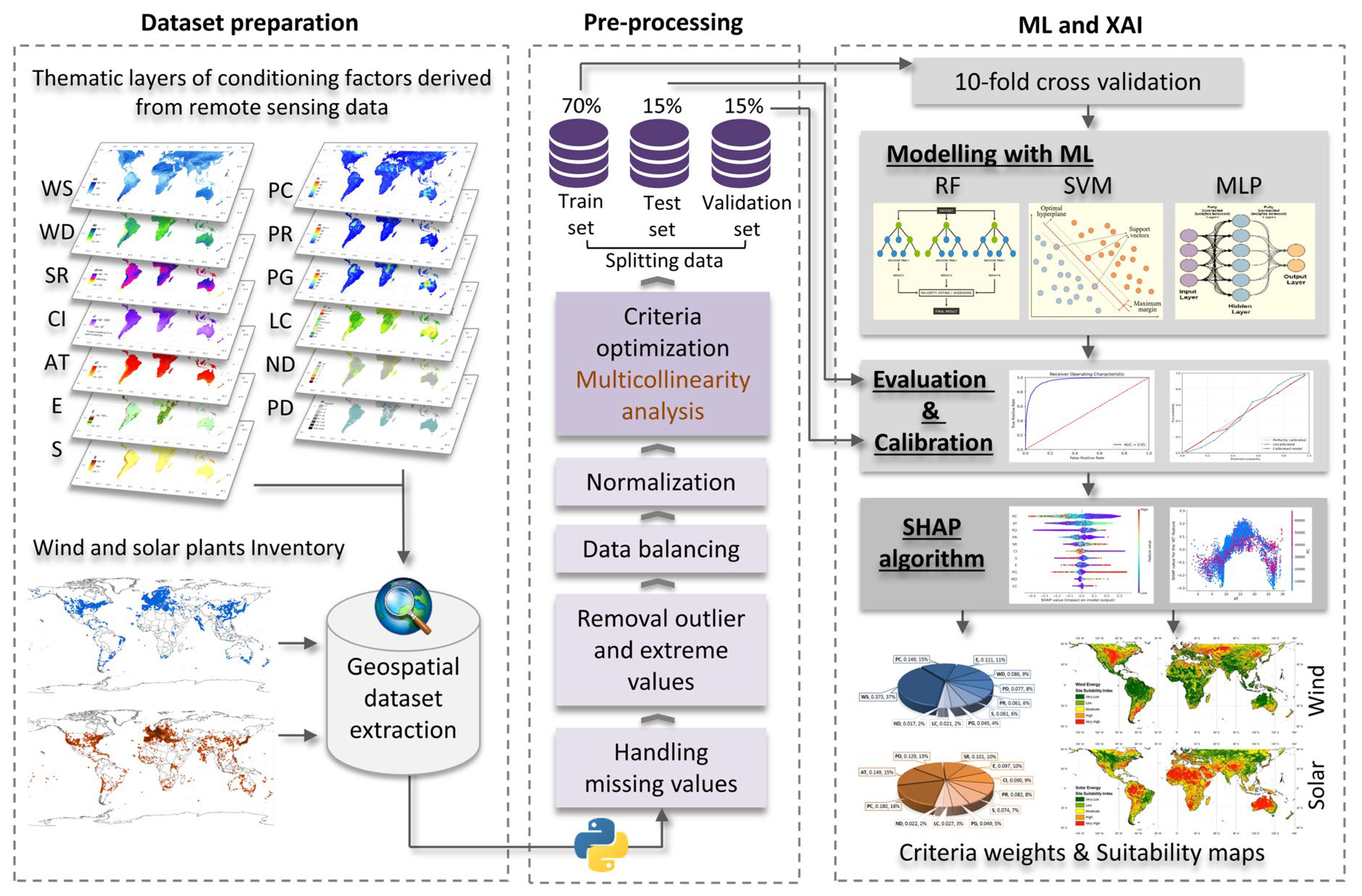



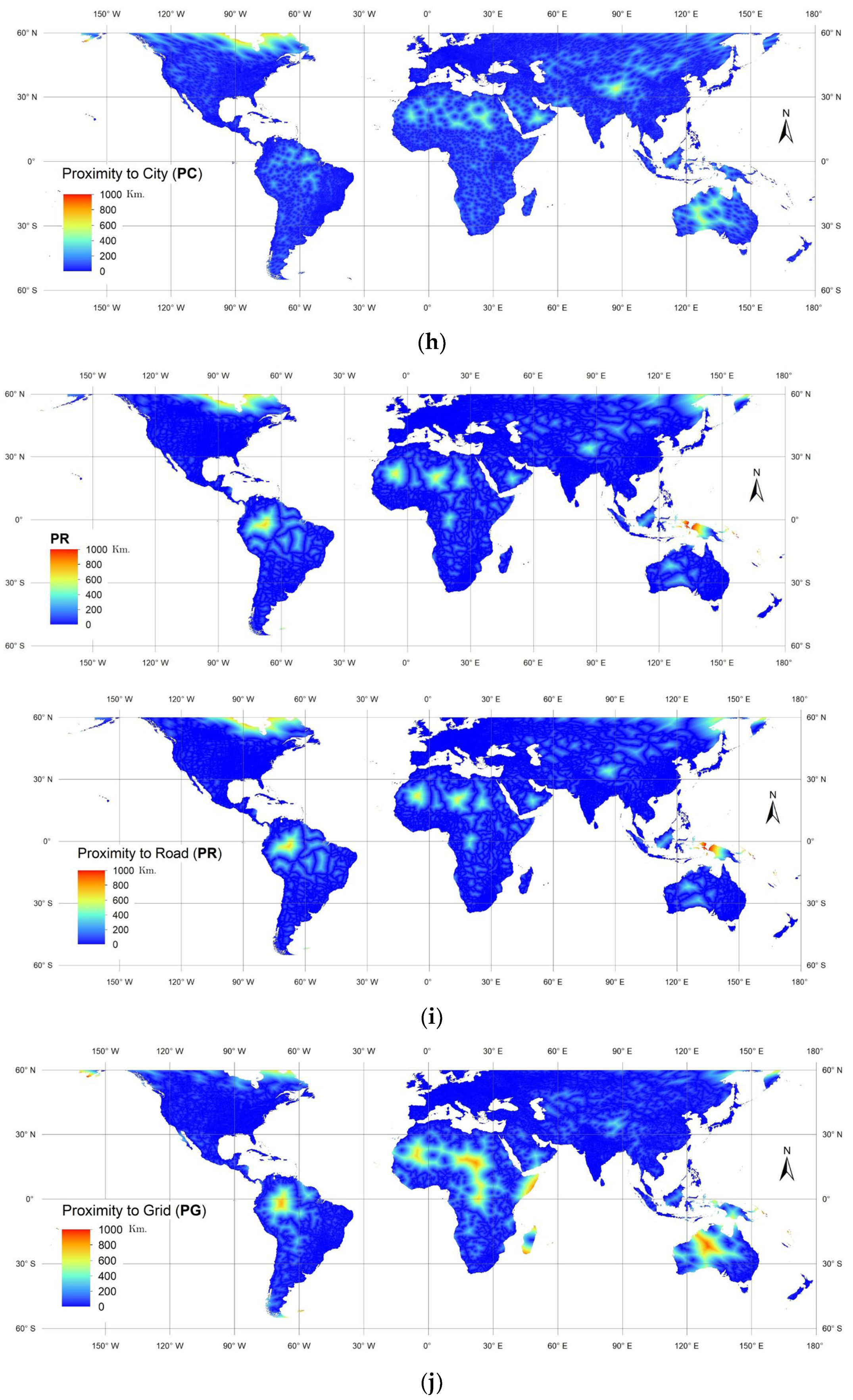
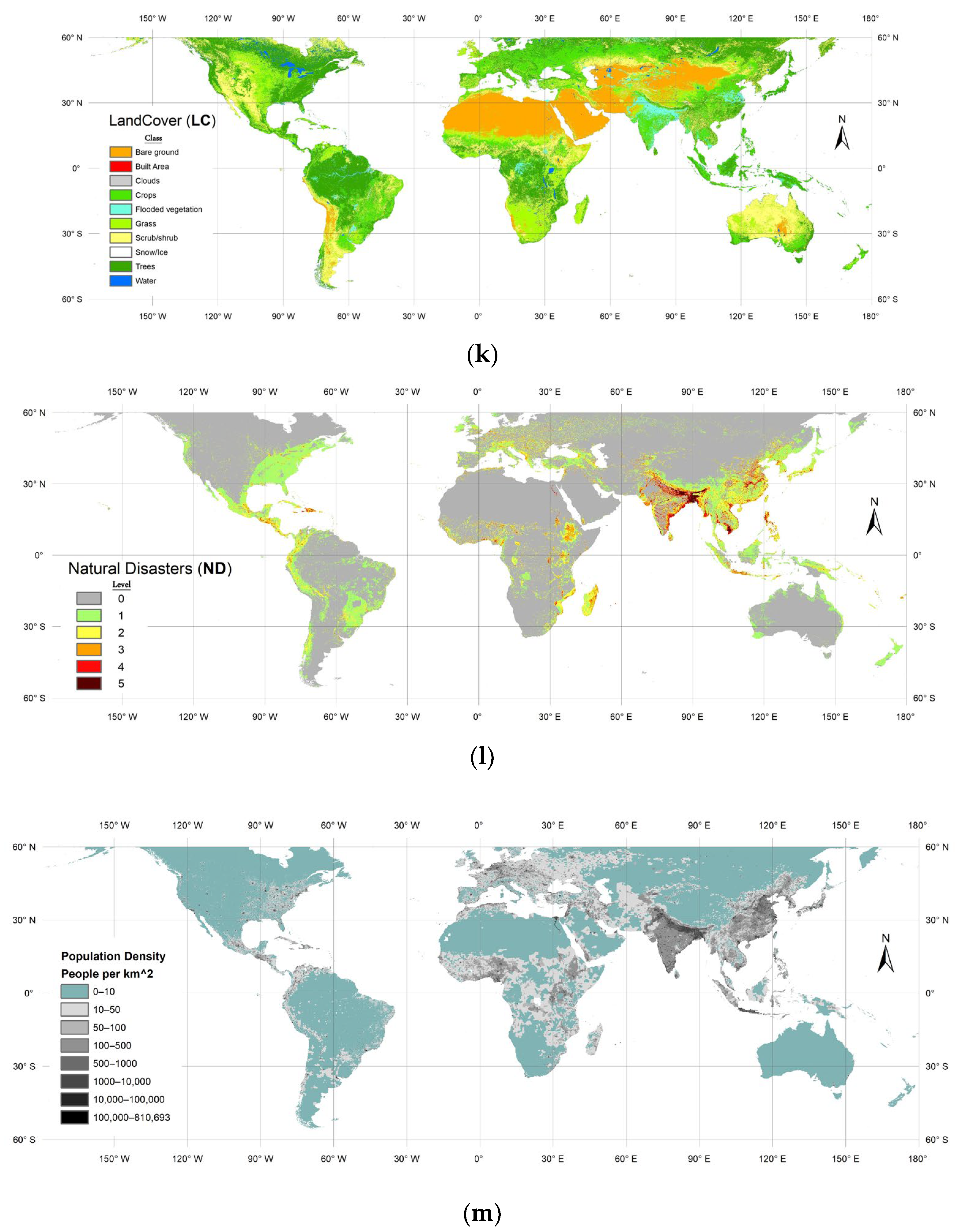

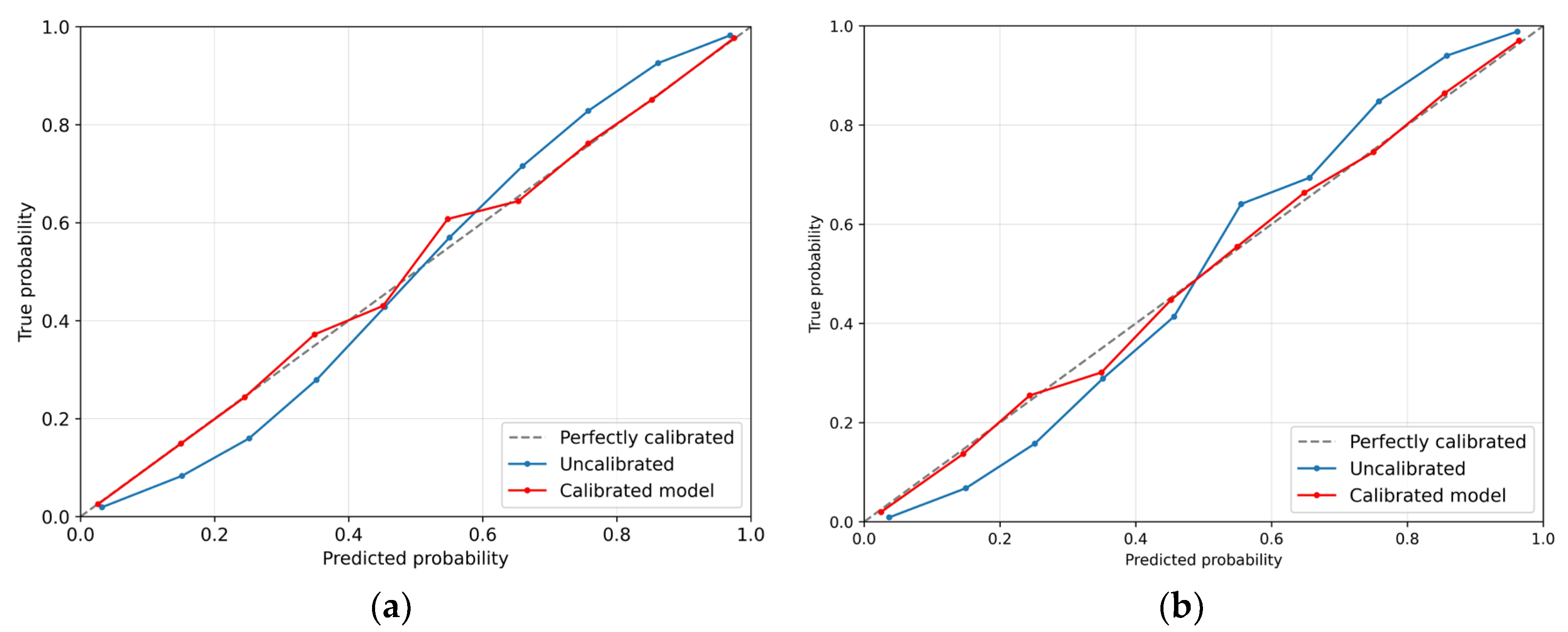

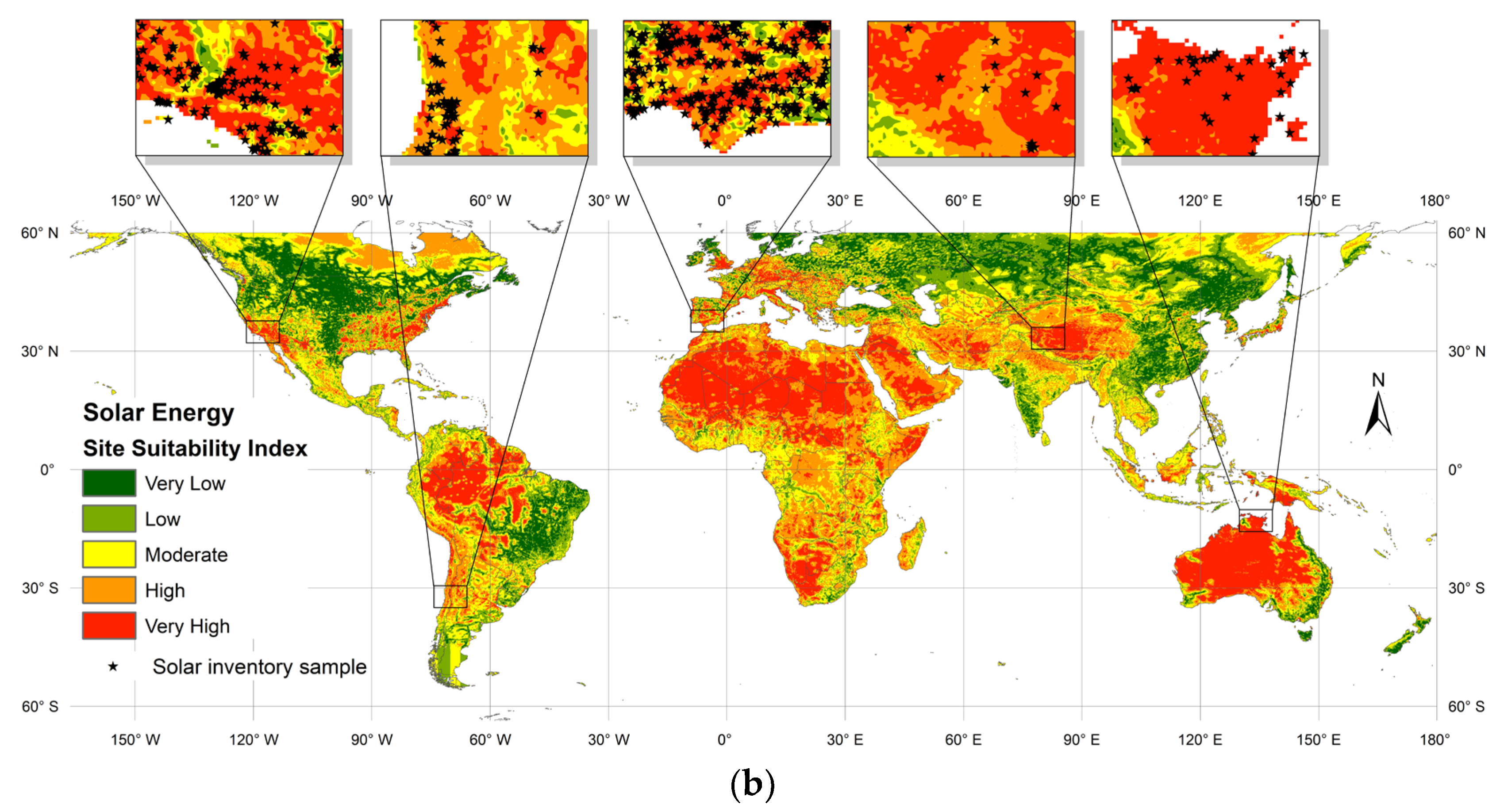
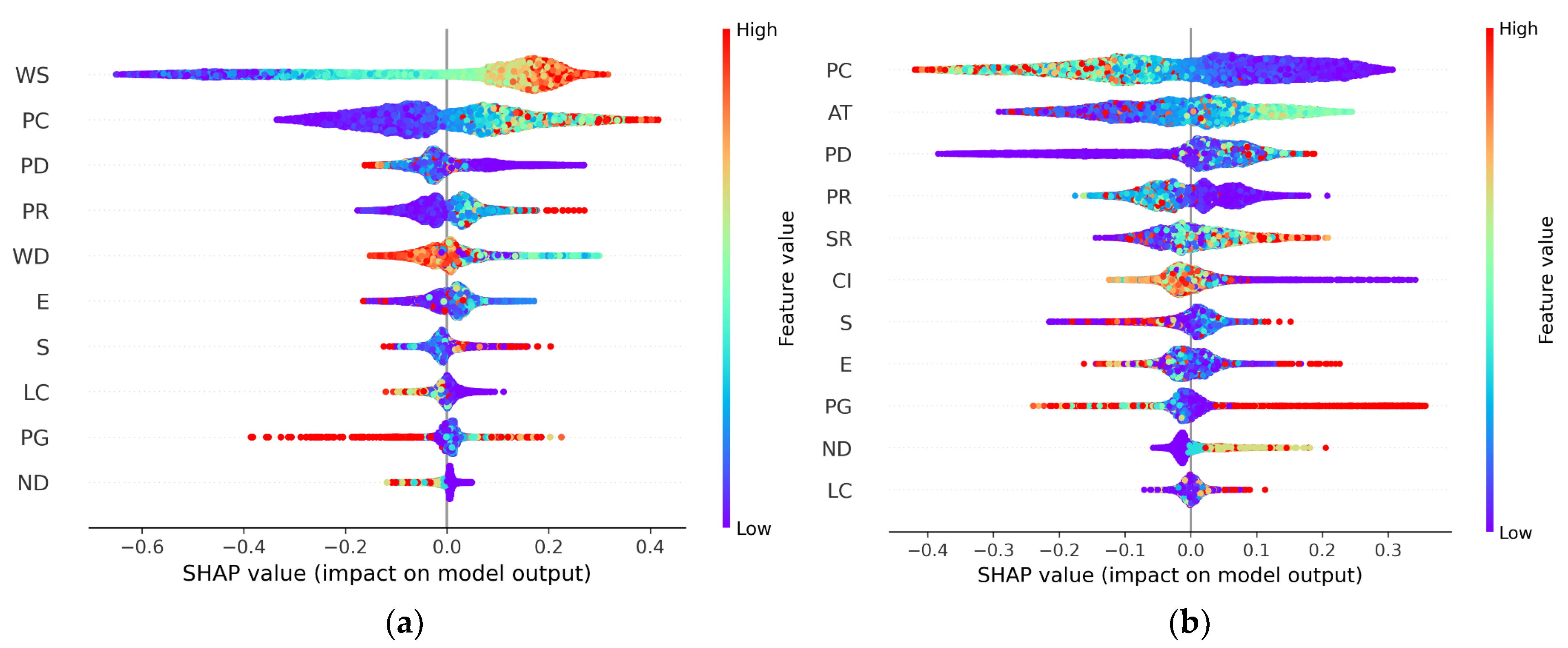
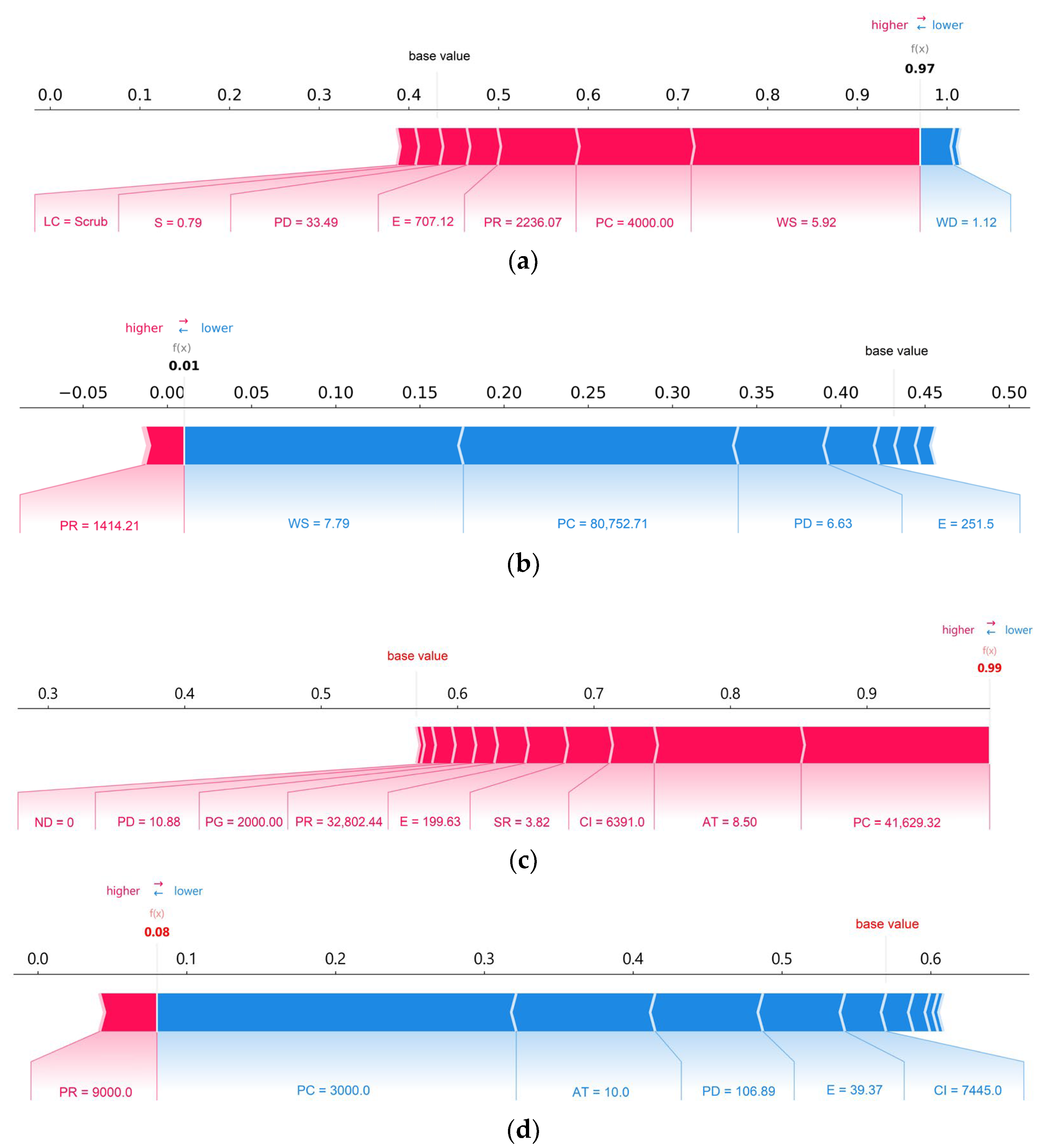
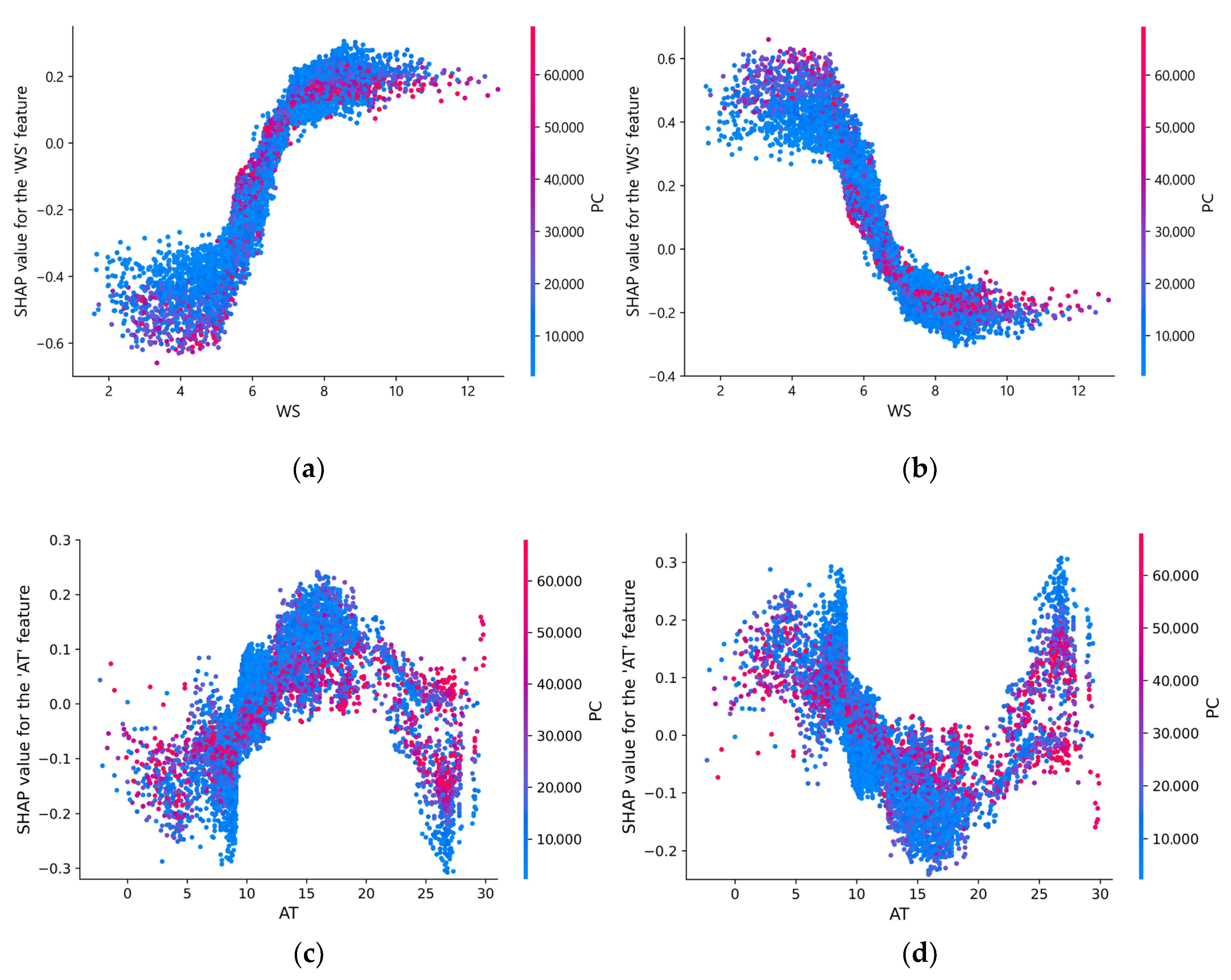
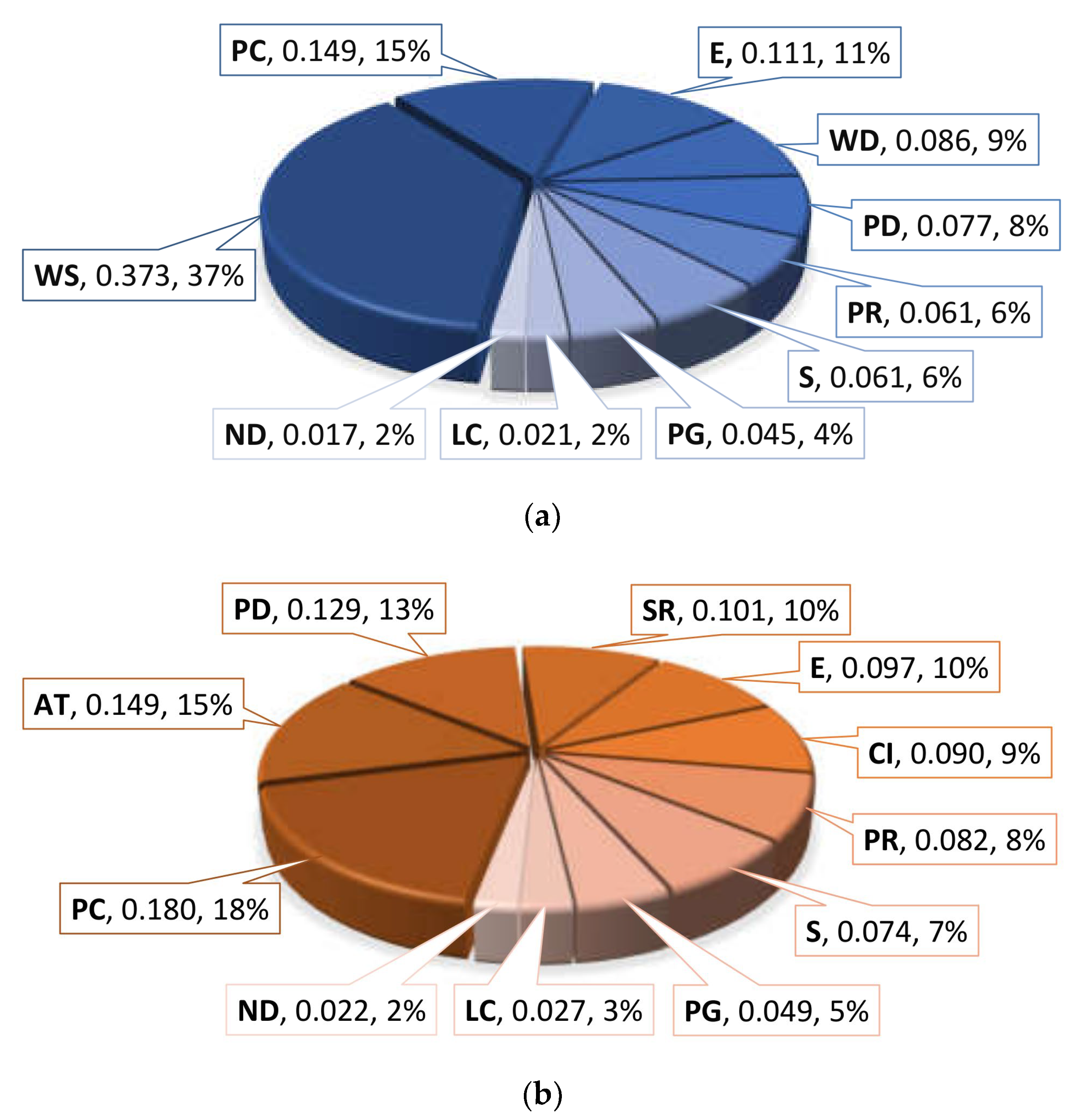
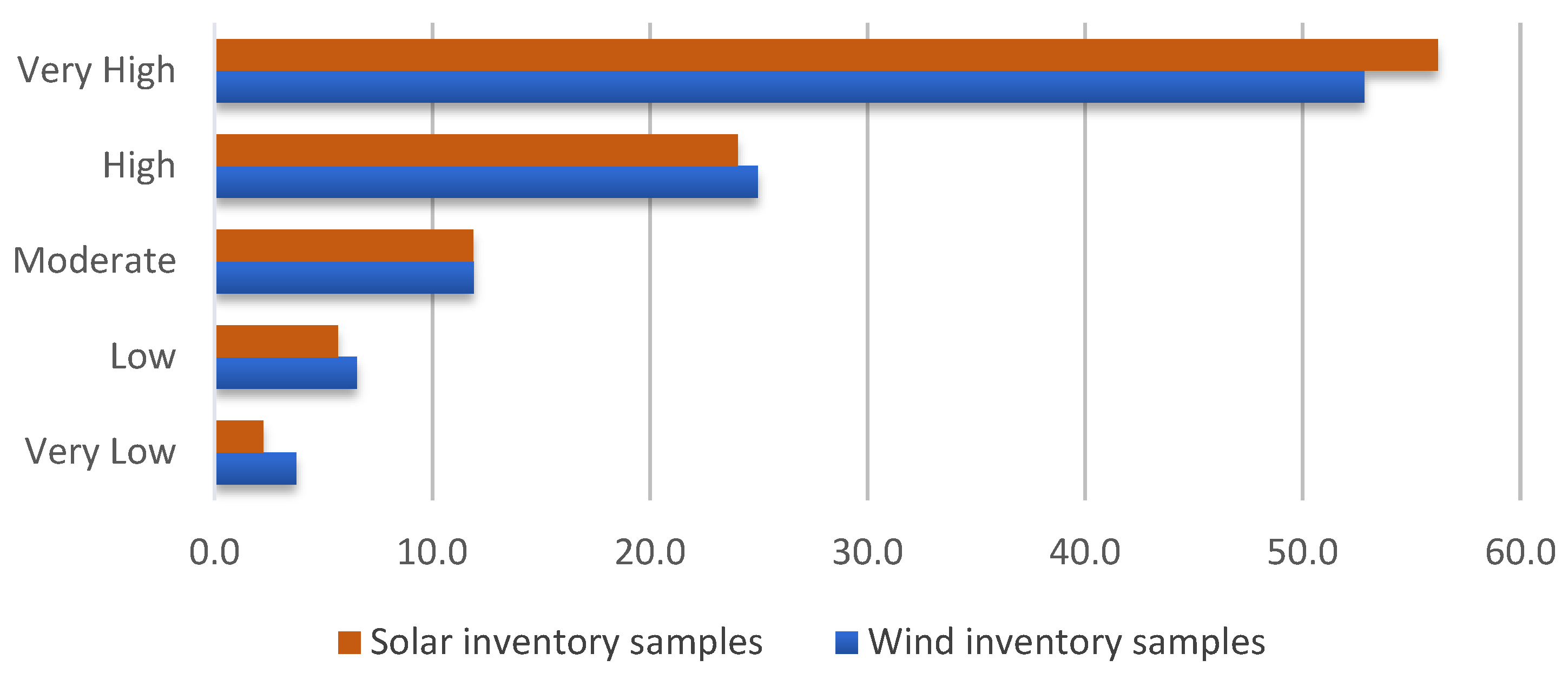
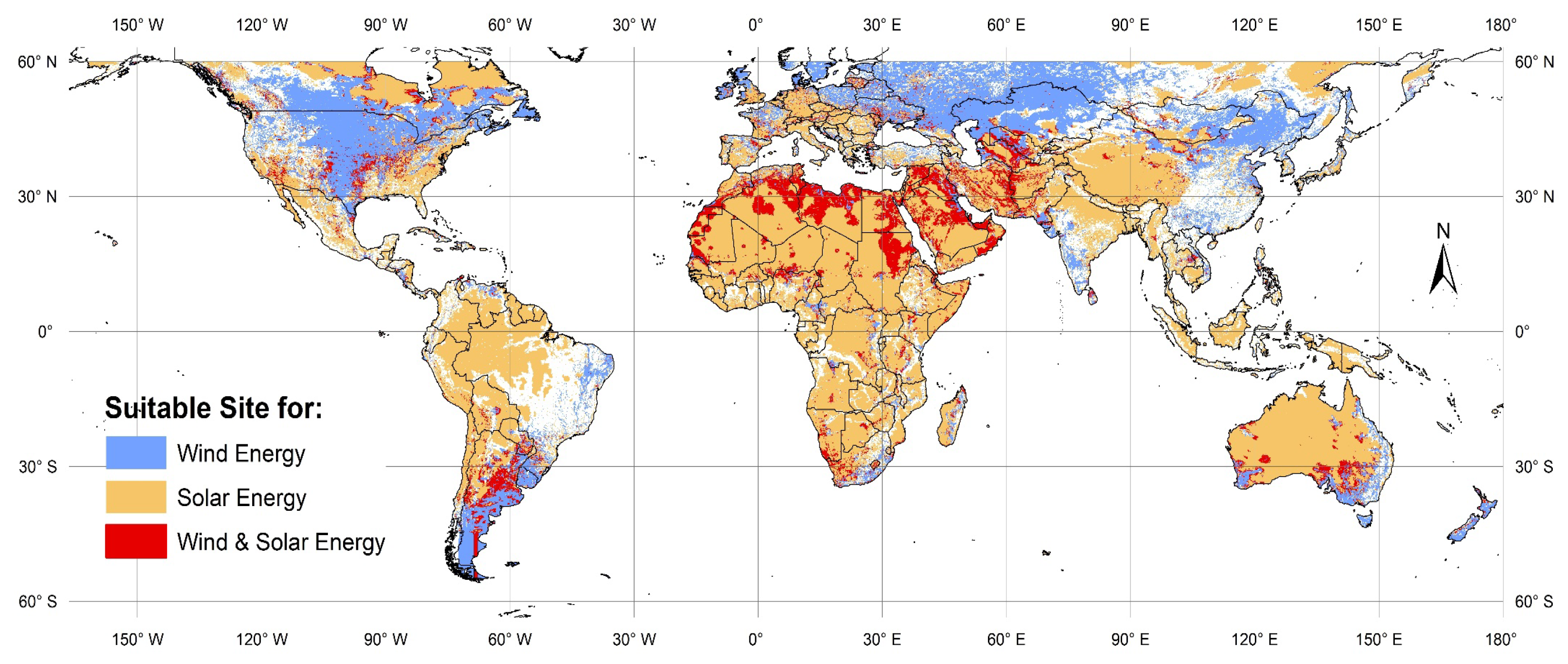
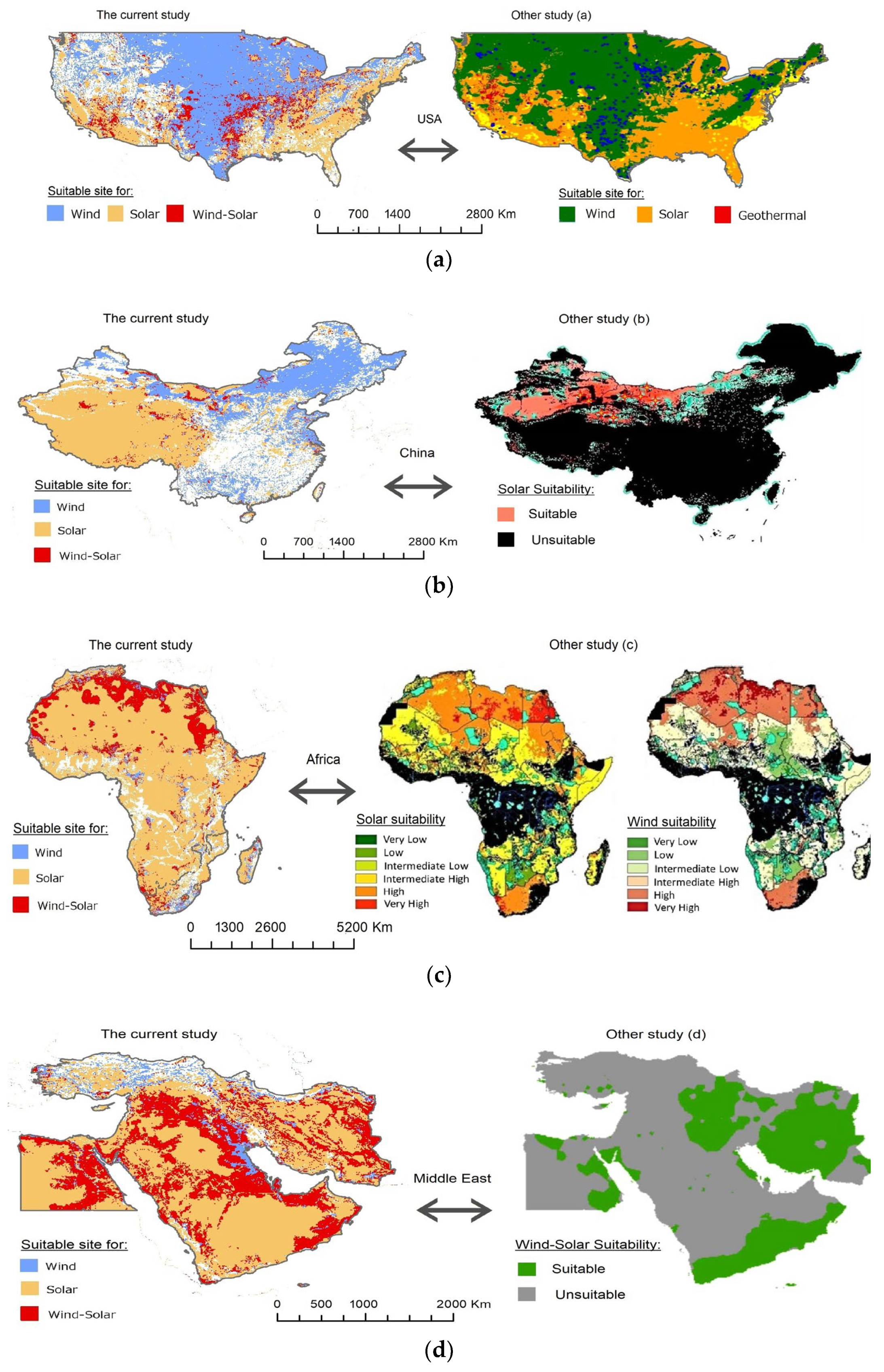
| Category | Factor | Dataset Name | Source | Format | Spatial Resolution | Updated to | Access Link | Access Date |
|---|---|---|---|---|---|---|---|---|
| Technical | WS | wind speed | Global Wind Atlas 3.1 | Raster | 1 km | Apr-21 | https://globalwindatlas.info/ | 15 December 2021 |
| WD | wind density | Global Wind Atlas 3.1 | Raster | 1 km | Apr-21 | https://globalwindatlas.info/ | 15 December 2021 | |
| SR | solar radiation atlas/GHI | Global Solar Atlas v2.6 | Raster | 1 km | Jul-21 | https://globalsolaratlas.info/map | 16 December 2021 | |
| AT | air temperature | Global Solar Atlas v2.6 | Raster | 1 km | Jul-21 | https://globalsolaratlas.info/map | 16 December 2021 | |
| CI | cloud cover index | EarthEnv project | Raster | 1 km | Jan-16 | https://www.earthenv.org/cloud | 2 January 2022 | |
| Economical | E | elevation | EarthEnv project | Raster | 1 km | May-18 | https://www.earthenv.org/topography | 5 January 2022 |
| S | slope | EarthEnv project | Raster | 1 km | May-18 | https://www.earthenv.org/topography | 6 January 2022 | |
| PC | world cities and towns | NASA, NGIA, and USGS | CSV | X | Jul-21 | https://simplemaps.com/data/world-cities | 1 February 2022 | |
| PR | world roads | ArcGIS Hub, Esri | Vector | X | Jun-20 | https://hub.arcgis.com/maps/Story::world-roads | 9 February 2022 | |
| PG | global energy infrastructure | Published article | Vector | X | Jan-20 | https://gridfinder.org/ | 11 February 2022 | |
| Environ-mental | LC | Esri 10-Meter Land Cover | Esri | Raster | 10 m | Jul-21 | https://livingatlas.arcgis.com/landcover/ | 18 January 2022 |
| ND | natural disasters/multihazard | UNISDR | Raster | 10 km | Jan-15 | https://preview.grid.unep.ch/ | 14 February 2022 | |
| Social | PD | population density, v4.11 | SEDAC, NASA | Raster | 1 km | Jan-20 | https://sedac.ciesin.columbia.edu/data/set/gpw-v4-population-density-rev11 | 26 February 2022 |
| Factor | Wind Dataset | Solar Dataset | ||
|---|---|---|---|---|
| T | VIF | T | VIF | |
| WS | 0.823 | 1.215 | ||
| WD | 0.113 | 8.876 | ||
| SR | 0.109 | 9.174 | ||
| AT | 0.214 | 4.680 | ||
| CI | 0.229 | 4.365 | ||
| LC | 0.919 | 1.088 | 0.854 | 1.170 |
| S | 0.811 | 1.233 | 0.787 | 1.271 |
| E | 0.114 | 8.760 | 0.343 | 2.912 |
| PG | 0.760 | 1.316 | 0.741 | 1.349 |
| PR | 0.759 | 1.318 | 0.761 | 1.313 |
| PC | 0.905 | 1.105 | 0.924 | 1.082 |
| ND | 0.861 | 1.161 | 0.895 | 1.117 |
| PD | 0.937 | 1.067 | 0.908 | 1.101 |
| Metric | Wind Modeling | Solar Modeling | ||||
|---|---|---|---|---|---|---|
| RF | SVM | MLP | RF | SVM | MLP | |
| 0.88 | 0.70 | 0.79 | 0.91 | 0.74 | 0.77 | |
| 0.91 | 0.75 | 0.81 | 0.88 | 0.70 | 0.70 | |
| 0.90 | 0.74 | 0.80 | 0.89 | 0.72 | 0.73 | |
| 0.79 | 0.46 | 0.59 | 0.78 | 0.42 | 0.45 | |
| AUC | 0.96 | 0.73 | 0.89 | 0.95 | 0.71 | 0.72 |
| Suitability Degree | Wind Suitability Map | Solar Suitability Map | ||
|---|---|---|---|---|
| km2 | % | km2 | % | |
| Very Low | 38,667,400 | 33.4 | 15,933,000 | 13.8 |
| Low | 30,189,100 | 26.1 | 21,911,900 | 18.9 |
| Moderate | 20,057,400 | 17.3 | 27,601,900 | 23.8 |
| High | 15,027,100 | 13.0 | 27,798,800 | 24.0 |
| Very High | 11,814,800 | 10.2 | 22,510,200 | 19.4 |
| Total | 115,755,800 | 100 | 115,755,800 | 100 |
Publisher’s Note: MDPI stays neutral with regard to jurisdictional claims in published maps and institutional affiliations. |
© 2022 by the authors. Licensee MDPI, Basel, Switzerland. This article is an open access article distributed under the terms and conditions of the Creative Commons Attribution (CC BY) license (https://creativecommons.org/licenses/by/4.0/).
Share and Cite
Sachit, M.S.; Shafri, H.Z.M.; Abdullah, A.F.; Rafie, A.S.M.; Gibril, M.B.A. Global Spatial Suitability Mapping of Wind and Solar Systems Using an Explainable AI-Based Approach. ISPRS Int. J. Geo-Inf. 2022, 11, 422. https://doi.org/10.3390/ijgi11080422
Sachit MS, Shafri HZM, Abdullah AF, Rafie ASM, Gibril MBA. Global Spatial Suitability Mapping of Wind and Solar Systems Using an Explainable AI-Based Approach. ISPRS International Journal of Geo-Information. 2022; 11(8):422. https://doi.org/10.3390/ijgi11080422
Chicago/Turabian StyleSachit, Mourtadha Sarhan, Helmi Zulhaidi Mohd Shafri, Ahmad Fikri Abdullah, Azmin Shakrine Mohd Rafie, and Mohamed Barakat A. Gibril. 2022. "Global Spatial Suitability Mapping of Wind and Solar Systems Using an Explainable AI-Based Approach" ISPRS International Journal of Geo-Information 11, no. 8: 422. https://doi.org/10.3390/ijgi11080422
APA StyleSachit, M. S., Shafri, H. Z. M., Abdullah, A. F., Rafie, A. S. M., & Gibril, M. B. A. (2022). Global Spatial Suitability Mapping of Wind and Solar Systems Using an Explainable AI-Based Approach. ISPRS International Journal of Geo-Information, 11(8), 422. https://doi.org/10.3390/ijgi11080422









